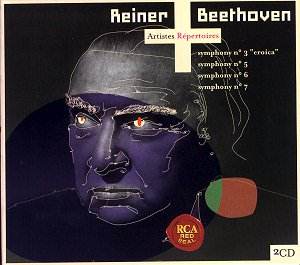Beethoven from the "Golden Age" - or
is it? The problem with having a reputation is that everyone expects
you to keep it, and perform accordingly. So, does Reiner do this?
I had not heard these performances before. Knowing the results
Reiner obtained with other works, however, gives one expectations
of the finished article that are not always borne out, and I am
afraid that that is shown in these discs. This is not to say that
all is doom and gloom; entirely the contrary! The first and last
are superb, but the middle two leave some questions to be answered.
However to the individual items.
In the Eroica, Reiner is in his element; full
of power, hard driven, but not so hard as to be unacceptable.
This is a very quick reading, surprisingly so for the year of
performance (1955). The sound for this era is incredibly good;
true, the strings are a bit wiry, but otherwise it would pass
for at least 20 years later. At the start of the first movement,
the playing is savage, but later (3’18) shows touches of tenderness.
The violins are together well in the pizzicato sections and inner
parts are very clear. In this they are helped by a quite reverberant
acoustic. In contrast, the second movement is Adagio very assai,
and taken at a speed of crotchet = 30, but this does not prevent
the movement being well held together, as one would expect. The
fugue is well enunciated and the speed is steady and unvaried
throughout. The third movement is a very fast presto, a dotted
minim = 120, quicker than Norrington and very crisp although at
the start the violins are surprisingly scrappy. The fourth movement
is taken at a more steady crotchet = 120, and apart from a very
reedy oboe is unremarkable. However the symphony as a whole is
very exciting.
The fifth symphony is a disappointment. I expected
a similarly hard-driven performance but it turned out rather routine.
The recording here sounds its age, which doesn’t help and there
is not as much light and shade in the individual movements as
one would have liked.
The sixth symphony also is given a precise but
prosaic reading. The whole symphony is played almost in a matter
of fact approach and the first four movements do not dance enough.
In fact the playing does not take off until the final movement
which is much more definite and lilting in character. The recording
here is very much better and of course being much later gains
benefit.
The seventh symphony is the other big success
of these performances. This is much more to Reiner’s style, with
very marked impulse and drive. Again the recording is excellent,
and a very natural sound is obtained. The second movement emerges
as a true allegretto, and is absolutely right for the music, allowing
the contrasting themes to come through. The scherzo is more meno
presto, but dances nicely. The final movement is extremely fiery
and fast, with hammer-blow chords at the beginning and in the
reprise. This is allegro con molto brio.
So, the performances are a bit of a curate’s
egg. What I cannot forgive is the appalling packaging of the product.
BMG France are responsible for this production. There is the minimum
of description of the works. The two discs are packaged in one
of those "glossy cardboard" folders with plastic inserts
for the discs. Should these break or give way, there is no possibility
of being able to repair or replace the container. There is no
information about Reiner whatsoever, and the whole thing looks
cheap and nasty. I do not see that we, as music lovers and collectors
should have to put up with these standards of presentation. Other
companies, but also BMG, please take note!
John
Portwood
